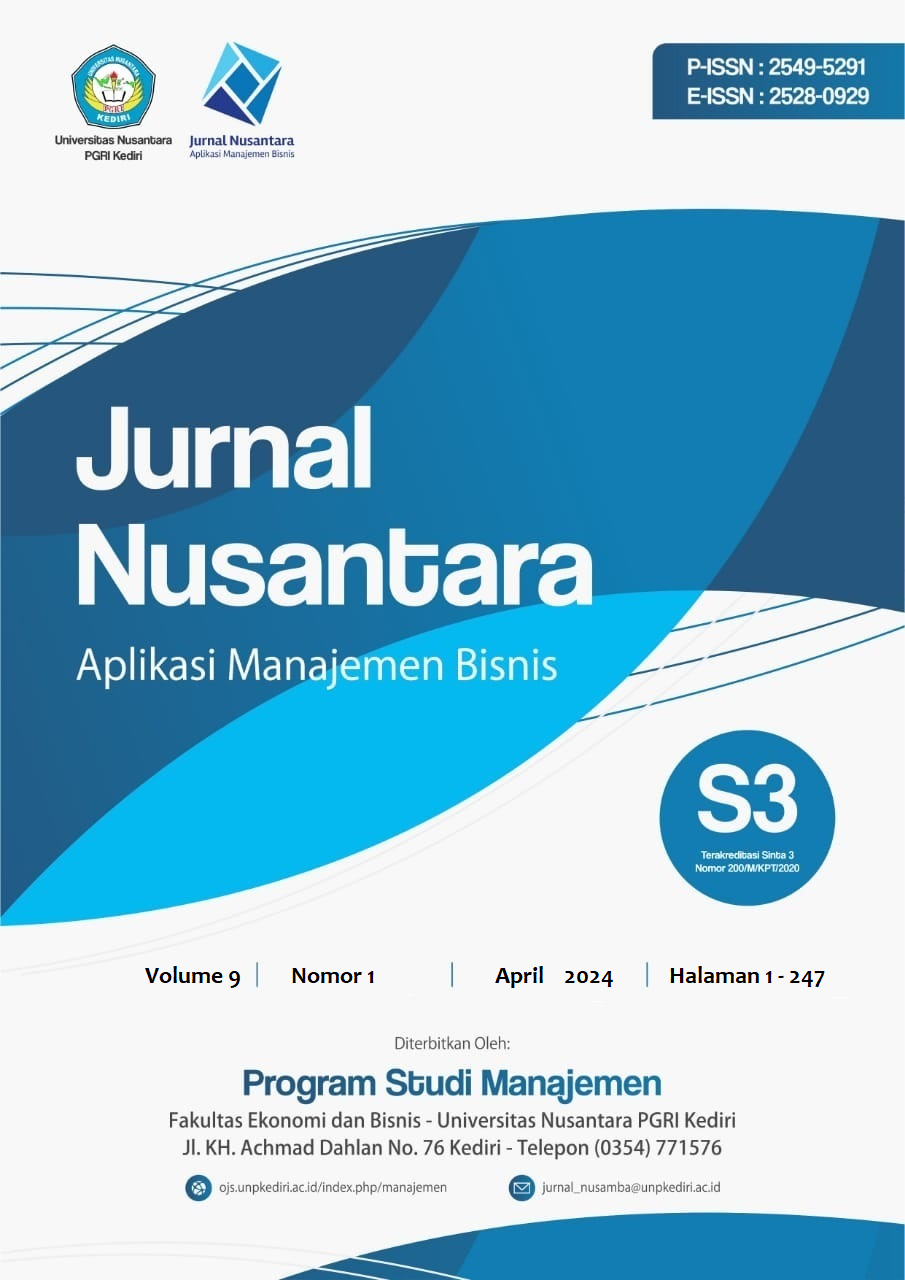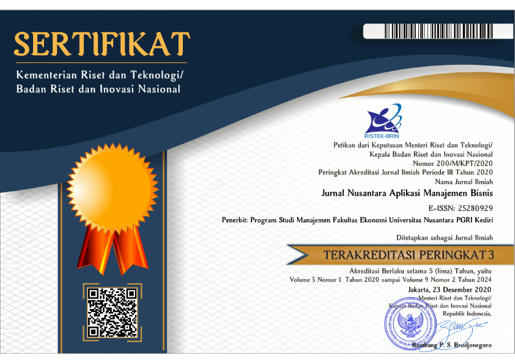Measuring the Efficiency of State-Owned Stocks Using Capital Asset Pricing Model (CAPM)
DOI:
https://doi.org/10.29407/nusamba.v9i1.21162Keywords:
Capital Asset Pricing Model, capm, Stock EfficiencyAbstract
Abstract
Research aim : This study examines market efficiency using the Capital Asset Pricing Model (CAPM) method on BUMN stocks in Indonesia.
Design/Methode/Approach : This model explains the relationship between risk and return in an efficient market. The analysis focuses on using stock beta calculations for 5 years.
Research Finding : The research results are as follows: 1) the BUMN stock market in Indonesia is classified as efficient, namely 11 stocks where 5 companies have positive individual returns, namely ANTM, TINS, KRAS, BBNI, and PGAS. There are 6 companies that have negative returns, namely WSKT, ADHI, WIKA, PTPP, SMBR, and BBTN. 2) the analysis was carried out during the covid-19 pandemic period, the basic material sector is a collection of stocks that are classified as resilient during the pandemic showing positive and efficient returns. 3) overall, there is a high systematic risk of BUMN stocks in Indonesia, and actively responds to any changes that occur in market prices.
Theoretical contribution/Originality : This contribution is expected to be a reference for investors and market participants.
Practitionel/Policy implication : These results provide information for investors to choose efficient State-Owned Enterprises (BUMN) stocks in deciding to invest and still consider the nature and characteristics of each investor.
Research limitation : Future research is expected to use other methods in analyzing the level of stock risk such as Arbitrage Pricing Theory (APT) or estimating future stock prices using the ARIMA / GarCH forecasting method and increasing the number of samples in the study or different market indices so that the expected results are more accurate in predicting future stock prices.
Downloads
References
2. https://www.cnbcindonesia.com/market/20220407102231-17-329580/ini-5-saham-bumn-paling-seksi-2022-mau-borong-ga.
3. Wardono Dwi Urip, Krisna Aprileo Iskandar Putra, Aqil Lukmanul Hakim SA. Jurnal Pendidikan dan Konseling. J Pendidik dan Konseling. 2022;4:1349–58.
4. Ramadhan T, Kholiq Mahfud M, Manajemen J. Deteksi Perilaku Herding Pada Pasar Saham Indonesia & Singapura Tahun 2011-2015. Diponegoro J Manag [Internet]. 2016;5(2):1–9. Available from: http://ejournal-s1.undip.ac.id/index.php/dbr
5. Untari MDA. The Influence Of Follower Investor Behaviour To The Stock Of Volatility. J Ilm Akunt dan Bisnis [Internet]. 2017;12(1):44–53. Available from: https://ojs.unud.ac.id/index.php/jiab/article/view/25857/17842
6. Boďa M, Kanderová M. Linearity of the Sharpe-lintner Version of the Capital Asset Pricing Model. Procedia - Soc Behav Sci. 2014;110.
7. Markowitz H. The Portfolio selection. J Finance. 1952;7(1):77–91.
8. Li Y, Zhou B, Tan Y. Portfolio optimization model with uncertain returns based on prospect theory. Complex Intell Syst. 2022;8(6).
9. Sharpe WF. Capital Asset Prices: a Theory of Market Equilibrium Under Conditions of Risk. J Finance. 1964;19(3):425–42.
10. Litner J. Security prices from diversification. Vol. 20, Journal of Finance. 1965. p. 587–615.
11. Jan M. Equilibrium in a Capital Asset Market. Econometrica. 1966;34(4):768.
12. Turlinda A, Hasnawati H. CAPITAL ASSET PRICING MODEL (CAPM) DAN ACCUMULATED / DISTRIBUTION LINE UNTUK PENENTUAN KELOMPOK SAHAM-SAHAM EFISIEN. J Pajak dan Keuang Negara. 2021;2(2).
13. Balatif MR, Harahap AM, Sadalia I. Seminar Nasional Ilmu Sosial dan Teknologi (SANISTEK) Perbandingan Capital Asset Pricing Model dan Arbitrage Pricing Theory dalam Memprediksi Tingkat Expected Return. Semin Nas Ilmu Sos dan Teknol [Internet]. 2021;324–9. Available from: https://kemenperin.go.id
14. Khan I, Gul M, Khan NM, Nawaz B, Sanaullah M. Assessing and testing the Capital Asset Pricing Model (CAPM): a study involving KSE-Pakistan. Glob J Manag Bus Res. 2012;12(10).
15. Bajpai S, Sharma AK. An Empirical Testing of Capital Asset Pricing Model in India. Procedia - Soc Behav Sci. 2015;189.
16. Rutkowska-Ziarko A, Markowski L, Pyke C, Amin S. Conventional and downside CAPM: The case of London stock exchange. Glob Financ J. 2022;54.
17. Kumar G, Misra AK. Liquidity-adjusted CAPM — An empirical analysis on Indian stock market. Cogent Econ Financ. 2019;7(1).
18. Rocciolo F, Gheno A, Brooks C. Explaining abnormal returns in stock markets: An alpha-neutral version of the CAPM. Int Rev Financ Anal. 2022;82.
19. Marty W. Marty, W. (2015). Performance measurement. Portfolio Analytics: An Introduction to Return Risk Measurement, 141-180. Springer Texts Bus Econ [Internet]. 2015;141–80. Available from: https://link.springer.com/chapter/10.1007/978-3-319-19812-5_4
20. Kurniawan RF, Sari HMK. Analysis of Optimal Portfolio Formation During the Covid-19 Pademic Using the Capital Asset Pricing Model (CAPM) Model for IDX-30 Shares in the 2020 Period. Indones J Innov Stud. 2023;22:1–15.
21. Pramono ES, Rudianto D, Siboro F, Abdul Baqi MP, Julianingsih D. Analysis Investor Index Indonesia with Capital Asset Pricing Model (CAPM). Aptisi Trans Technopreneursh. 2022;4(1).
22. Putra YP, Setiorini H, Suhendra C. Analisis Keakuratan Capital Asset Pricing Model dan Arbitrage Pricing Theory dalam Memprediksi Return Saham (Studi pada Perusahaan LQ 45 Di Bursa Efek Indonesia Periode 2016-2020). Ekombis Rev. 2023;11(1).
23. Basu S. INVESTMENT PERFORMANCE OF COMMON STOCKS IN RELATION TO THEIR PRICE‐EARNINGS RATIOS: A TEST OF THE EFFICIENT MARKET HYPOTHESIS. J Finance. 1977;32(3).
24. Banz RW. The Relative Efficiency of Various Portfolios: Some Further Evidence: Discussion. J Finance. 1980;35(2).
25. BHANDARI LC. Debt/Equity Ratio and Expected Common Stock Returns: Empirical Evidence. J Finance. 1988;43(2).
26. FAMA EF, FRENCH KR. The Cross‐Section of Expected Stock Returns. J Finance. 1992;47(2):427–65.
27. Altay E, Çalgıcı S. Liquidity adjusted capital asset pricing model in an emerging market: Liquidity risk in Borsa Istanbul. Borsa Istanbul Rev. 2019;19(4).
28. Jogiyanto H. Teori Portofolio dan Analisis Investasi. Kesebelas. Yogyakarta: BPFE; 2017.
29. https://www.bi.go.id/id/publikasi/ruang-media/news-release/Pages/sp_2333221.aspx.
30. Nia VM. The Effect Of Corona Outbreak on the Indonesian Stock Market. Am J Humanit Soc Sci Res . 2020;4(3).
Downloads
Published
Issue
Section
License
Authors who publish with this journal agree to the following terms:
- Copyright on any article is retained by the author(s).
- The author grants the journal, the right of first publication with the work simultaneously licensed under a Creative Commons Attribution License that allows others to share the work with an acknowledgment of the work’s authorship and initial publication in this journal.
- Authors are able to enter into separate, additional contractual arrangements for the non-exclusive distribution of the journal’s published version of the work (e.g., post it to an institutional repository or publish it in a book), with an acknowledgment of its initial publication in this journal.
- Authors are permitted and encouraged to post their work online (e.g., in institutional repositories or on their website) prior to and during the submission process, as it can lead to productive exchanges, as well as earlier and greater citation of published work.
- The article and any associated published material is distributed under the Creative Commons Attribution-ShareAlike 4.0 International License












